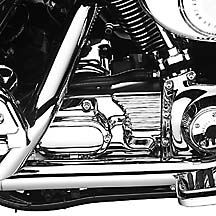
Touring Oil Cooler
| Tips and Tricks They Don't Tell You About | |||||||||
|
The Harley Davidson Oil Cooler accessory (Part No. 62868-99 and Cover Part No. 74601-99 ) for the Road King is very aesthetically designed, and its appearance flows well with the overall look of the dressed bike. However, there are a few things that they don't tell about right away, that you need to be prepared for.
First and foremost: The two lines for the oil cooler will replace one of the elbow lines from your oil pump, and the routing of these lines will not allow continued use of the standard black oil line cover located just behind the right side chrome engine cover. If you wish to hide the oil lines, you will need to purchase one of the Harley "Transmission Interface" covers, (list price of around $60) so add one of these to your shopping list! Be sure to also add some Teflon tape or Permatex thread sealant to the list as well, for the included replacement hose nipples.
 66096-02 Transmission Interface Cover |
 66503-00 Ribbed Transmission Interface Cover |
Second: The chrome oil cooler cover is a glue on affair (what's up with that??). You are instructed to glue the cover on with silicone adhesive. (I don't remember, but I don't think the adhesive was included in the pack). The initial problem with gluing the cover on is that when you glob on the silicone, it acts as a lubricant, and the cover won't stay on long enough to adhere, so do yourself a favor and glue the cover on before installation and wrap bungee cords or temporary wire ties around the assembly and let it cure for a day. Slide the cover on and off until you can tell where the adhesive needs to be (or just pile it up on the ends). Use a generous amount of adhesive, let it cure well, then spend the rest of your life worrying about the stupid thing falling off and destroying your back tire someday!!! :-( (6000 miles, so far, so good)
Third: As the two lines
for the oil cooler pass under the engine, there is
nothing to support them. The distance and weight of the
lines and flow valve will cause them to sag down, and be
vulnerable to road hazards and service jacks, not to
mention that it looks crappy. You can carefully drill a
small hole on the (bike right) side of the engine number
plate, and secure the lines to that plate with a wire tie
to keep them snug and safe. The right end of this cast in
number plate is hollow above it, so there is no danger of
drilling into the engine CAUTION!! Only the "bike right"
end of this plate is open!! Do not drill where you can't
feel a space above it!! |
|
Finally: The oil cooler is not
designed to work with the Chrome Regulator Cover (part no. 74543-00)
(what a design team, eh?). However, a little ingenuity will
enable you to keep both on your bike. The Regulator cover is
installed to the bike with a set of post type mounts that replace
the stock hold down nuts. It is these posts that cause the
conflict with the oil cooler, as the lines from the cooler have
to pass right over the nuts (where the posts would be.
The work-around for this issue is to mount the regulator cover to
the regulator bracket, using small corner brackets, bolted to the
regulator bracket, then simply bolt the cover to the corner
brackets. This frees up the area for the oil lines. This will
require removal of the regulator and its bracket, so that the
bracket can be drilled. For a quick fix without removal, simply
bolt the corner brackets to the cover, then use a pair of black
wire ties around the oil lines and through the corner brackets to
snug the cover down. This is the method that I used, but it is so
well hidden that I can't photograph it for you.
Note for 2002 models: The electrical connection for the regulator is clipped directly underneath the regulator for 2002 models, and it is in the way of the oil cooler. You will have to remove it from its clip and secure it out of the way .Behind the regulator works well, in the hollow area of the regulator bracket, but make sure that it is clear of the motor mount movements.
|
| The new
TC-88 engines are well designed with increased cooling
mass incorporated into the fins, and the fuel injected
models have some heat compensating adjustments built in
as well. Some techs will tell you that these engines are
"Parade Tested" and don't need coolers. Well....I
didn't NEED a Road King, but I wanted one, and an
external oil cooler on ANY engine just makes good sense. Be aware that upon changing oil, you will not be able to drain the bike completely, as a small amount of old oil stays resident on the cooler and lines. This is not a big issue. Change your oil when you're supposed to and enjoy the ride!! |